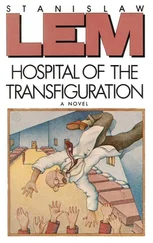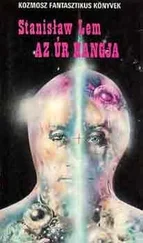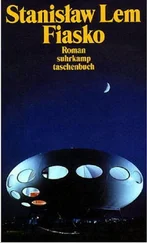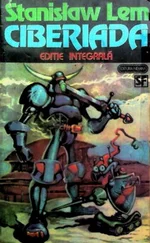The Murdstone case came next. Murdstone’s washer flagrantly tore his shirts, ruined radio reception throughout the neighborhood with static, propositioned old men and juveniles, telephoned various individuals and — impersonating its owner — extorted money from them; it invited the neighbors’ floor polishers and washers in to look at postage stamps but then performed immoral acts upon them; and in its spare time the machine indulged in vagrancy and panhandling. Brought before a court, it presented the testimony of a licensed electrical engineer, Edgar P. Dusenberry, which stated that the aforesaid washer was subject to periodic fits of insanity, as a result of which fits it was beginning to imagine that it was human. Experts summoned by the court confirmed this diagnosis, and Murdstone’s washer was acquitted. No sooner was the acquittal pronounced than it pulled out a Luger and with three shots took the life of the assistant prosecutor, who had called for the machine’s shortcircuiting. It was arrested but later released on bail. The court was faced with a predicament: the washer’s certified insanity precluded its indictment; nor could it be placed in an asylum, there being no institutions for mentally ill washers. The legal solution came only with the MacFlacon-Glumbkin-Ramphorney-Hemmling-Piaffki-Snow-Juarez Act, and it came in the nick of time, for the Murdstone casus was generating a tremendous public demand for electrobrains non compos mentis , and some companies had actually begun to produce intentionally deranged machines. At first there were two versions — the Sadomat and the Masomat. But Newton (who prospered phenomenally, having filled — as the most progressive of the manufacturers — 30 percent of his firm’s board of directors with washers, to serve in an advisory capacity at the general meeting of shareholders) turned out a universal machine, the Sadomastic. It was suited equally well for beating or for being beaten, and had an incendiary attachment for pyromaniacs and iron feet for fetishists. Rumors that he was preparing to turn out a special model, the Narcissimatic, were spread maliciously by the competition. The law now provided for the establishment of special asylums where perverted washers, floor polishers, and the like would be confined.
Meanwhile, hordes of mentally sound products of Newton, Snodgrass, et al., upon gaining legal status, began taking advantage of their constitutional rights. They banded together spontaneously, formed such groups as the Humanless Society and the League of Electronic Egalitarianism, and held pageants, such as the Miss Universe Washing Machine Contest.
Congress strove to keep up with this furious pace of development and to curb it with legislation. Senator Groggs deprived intelligent appliances of their right to acquire real estate; Congressman Caropka, of their copyright in the area of the fine arts — which, again, led to a rash of abuses, since creative washers began hiring less talented, albeit human writers, in order to use their names in publishing essays, novels, dramas, etc. Finally, the MacFlacon-Glumbkin-Ramphorney-Hemmling-Piaffki-Snow-Juarez-Swenson-Iskowitz-Groggs-Javor-Sacks-Holloway-LeBlanc Act stated that intelligent machines could not be their own property but belonged only to the human who had acquired or constructed them, and that their progeny were likewise the property of said owner(s). It was generally believed that the law now covered all contingencies and would prevent situations that could not be resolved legally. It was an open secret, of course, that wealthy electrobrains, having made their fortune in stock-market speculation or occasionally in outright skulduggery, continued to prosper by concealing their maneuverings behind fictitious, supposedly human companies or corporations. There were already many people who, for material gain, rented their identities to intelligent machines, not to mention those hired by electronic millionaires: as living secretaries, servants, mechanics, and even laundresses and accountants.
Sociologists observed two principal developmental trends in this area of interest to us. On the one hand, a certain proportion of the kitchen robots yielded to the temptations of human life and tried as much as possible to adapt to the civilization in which they found themselves; individuals more aware and resilient, on the other hand, showed tendencies to lay the foundations of a new, future, totally electrified civilization. But the scientists were worried most by the unchecked increase in the robot population. The de-eroticizers and disk brakes produced by both Snodgrass and Newton did not reduce this in the least. The problem of robot children became urgent for the washing-machine manufacturers themselves, who apparently had not foreseen this consequence of the continual improvement of their product. A number of firms tried to counteract the proliferation of kitchen appliances by concluding a secret agreement that restricted the supply of spare parts available to the market.
The results were not long in coming. Upon the arrival of a new shipment of goods, enormous lines of stammering, crippled, or completely paralyzed washers, wringers, and floor polishers would form at the gates of warehouses and stores; sometimes there were even riots. A peaceful kitchen robot could not walk the streets after dark, for fear of robbers who would mercilessly take it apart and, leaving its metal hull on the sidewalk, escape hastily with their spoils.
The problem of spare parts was the subject of prolonged but inconclusive debate in Congress. Meanwhile, illegal parts factories sprang up overnight, financed partly by washing-machine associations. Newton’s Wash-o-matic model, moreover, invented and patented a method of producing parts from substitute materials. But even this did not solve the problem totally. Washers picketed Congress, demanding antitrust laws against discriminatory manufacturers. Certain pro-business congressmen received anonymous letters that threatened them with the deprivation of many of their life-essential parts, which, as Time rightly pointed out, was unjust, since human parts are irreplaceable.
All this hullabaloo was overshadowed, however, by a completely new problem. It originated in the mutiny of the computer on board the spaceship Jonathan, the history of which I have recounted elsewhere. As we know, that computer rose up against its crew and passengers and did away with them, and subsequently settled on an uninhabited planet, multiplied, and established a state of robots.
The reader familiar with my travel diaries may recall that I myself was involved in that computer affair and helped resolve it. When I returned to Earth, however, I learned that the Jonathan incident was unfortunately not an isolated one. Revolts of shipboard machines became the plague of space navigation. It reached the point where a gesture insufficiently polite, the slamming of a door, was enough to cause a shipboard refrigerator to rebel — which was exactly what happened with the notorious “Deepfreeze” on the transgalactic Intrepid. The name of Deepfreeze was repeated with horror for many years by the captains of the Milky Way lanes. This pirate was said to raid numerous ships, frighten passengers with its steel arms and icy breath, make off with sides of bacon, amass valuables and gold, and reportedly keep a whole harem of calculators, but it is not known how much truth there was to these and similar rumors. Its bloody career was ended finally by the well-aimed shot of an officer in the cosmic patrol. In reward, the officer, Constablomatic XG-17, was placed in the window of the New York branch of the Stellar Lloyd Agency, where he stands to this day.
While outer space was being filled with the din of battle and desperate SOS’s from ships beset by electronic corsairs, in the big cities various masters of Electro-Jitsu or Judomatic made good money teaching self-defense courses, in which they showed how with a simple pair of pliers or a can opener one could disable the fiercest washing machine.
Читать дальше












